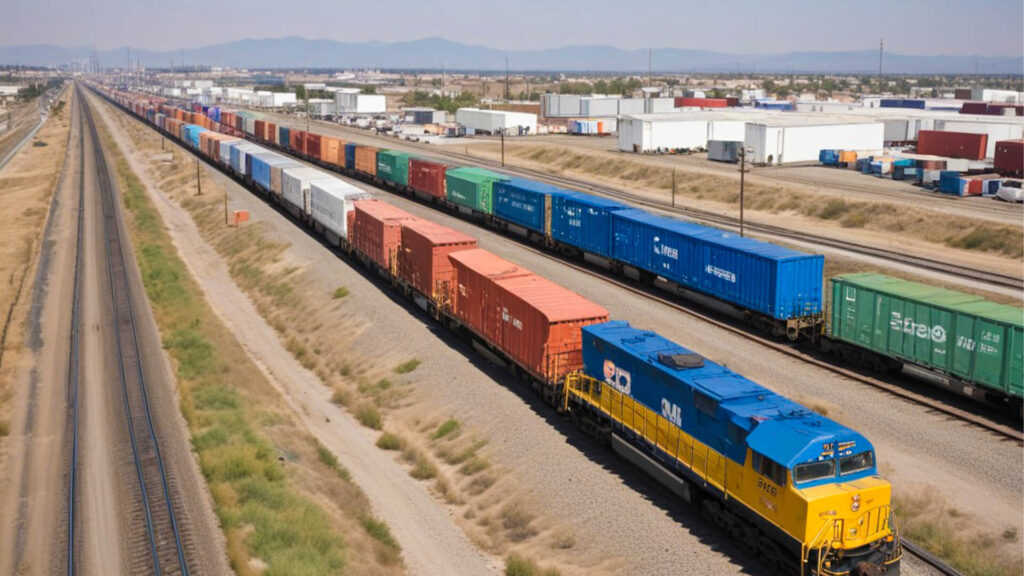This post was last updated on May 20th, 2024.
Intermodal transportation has become an increasingly significant aspect of modern logistics. But what exactly are the benefits that make it so attractive?
As intermodal transportation offers several advantages that can significantly improve a shipper’s overall shipping efficiency. These benefits are so compelling that shippers should strongly consider intermodal options when planning their transportation strategy.
This article will explore the specific advantages of using intermodal transportation. We’ll also define intermodal shipping and discuss the situations where it’s the most suitable option for shippers.
Intermodal Shipping at a Glance
Intermodal transportation offers a cost-effective and efficient way to move your goods. It combines two or more modes of transport, like ships, trucks, and trains to deliver your freight from its starting point to its final destination.
Here’s How It Works
Specially designed containers, called intermodal containers, carry all your freight. These containers are built to be easily transferred between different transportation modes without unloading the goods themselves. This eliminates the need for multiple handling, saving time and reducing the risk of damage.
There are two main types of intermodal shipments:
- Domestic: These shipments typically use larger, 53-foot containers and mainly involve transfers between trucks and trains within a country.
- International: For international shipments, smaller containers either 20 or 40 feet long, are used. These specially designed containers are crucial because they can seamlessly move between ships, trucks, and trains throughout the entire international shipping journey.
By understanding the different types of intermodal containers and how they work with each transportation mode, you can make informed decisions about the best way required to move your freight.
The Advantages of Intermodal Transportation
As we discussed earlier, intermodal transportation offers several significant benefits that can streamline your entire shipping process. So, Let’s delve into these advantages and see how they can bring about a positive impact on your supply chain:
Reduced Costs
Intermodal transportation often translates to significant cost savings, especially for longer distances. Here’s why:
- Lower Fuel Costs: Since trains are more fuel-efficient for land transportation, intermodal shipping uses less fuel overall.
- Reduced Handling Fees: Goods stay within the container throughout the journey, minimizing handling and lowering associated charges.
- Increased Cost-Effectiveness: Utilizing trains for long hauls reduces the cost per ton of freight moved, contributing to overall cost efficiency. (We’ll explore the sustainability aspect of this benefit further down.)
Greater Access to Capacity
Intermodal transportation offers substantial capacity, particularly on busy freight routes. With its reliance on rail, it provides a reliable solution during times of limited truck availability or driver shortages. Here’s how it works:
- Efficient Dray Operations: The short distances between origin/destination ramps and rail lines (typically under 100 miles) allow a single driver to manage multiple loads in a day.
- Double-Stacking on Rail Cars: Rail cars can stack containers on top of each other, effectively doubling their carrying capacity.
- Optimized Driver Utilization: Unlike truckload transportation where drivers work long distances between loads, intermodal allows for more efficient use of drivers.
Enhanced Safety
Intermodal transportation offers increased safety for your cargo by minimizing theft, accidents, and damage:
- Reduced Theft Risk: Rail transport for the majority of the land journey reduces the risk of theft compared to traditional truckload shipping.
- Constant Monitoring: Railroad police continuously track intermodal freight, along with high security levels at terminals and rail yards.
- Fewer Accidents: Rail travel experiences fewer accidents compared to road transportation, minimizing the risk of damage due to collisions.
- Reduced Handling: Keeping goods within containers during transport minimizes the chance of damage caused by handling.
- Safe Transport of Hazardous Materials: Trains are trusted for transporting hazardous materials. According to the American Association of Railroads, over 99.99% of hazardous materials reach their destination safely by rail.
Sustainability
Intermodal transportation stands out for its eco-friendly approach:
- Fuel Efficiency: As mentioned earlier, trains offer superior fuel efficiency for land transportation.
- High Freight Efficiency: A single train can carry the equivalent of hundreds of truckloads, maximizing freight movement with less impact.
- Reduced Carbon Footprint: By choosing intermodal transport, shippers can significantly reduce their carbon footprint due to the inherent efficiency of trains.
The Reasons Behind Intermodal’s Continued Rise
The trucking industry can be up and down. Good times can mean higher trucking prices, less space for cargo, and truck companies being choosier about the routes they take. On the other hand, bad times can lead to trucking companies going out of business, which means there’s less space for cargo overall.
The trucking industry can be up and down. Good times can mean higher trucking prices, less space for cargo, and truck companies being choosier about the routes they take. On the other hand, bad times can lead to trucking companies going out of business, which means there’s less space for cargo overall.
Here’s how intermodal transportation can help navigate these uncertainties:
- Protection from Price Ups and Downs: Intermodal pricing might not always be cheaper than truckload, but it’s more steady. This is important when truckload prices change a lot.
- Guaranteed Capacity: Intermodal transportation provides a vast amount of capacity, particularly on high-volume routes. This is crucial when truckload capacity tightens due to economic factors or regulations.
- Reliable Service: Contrary to some beliefs, intermodal service can be equal to or even better than truckload. Choosing the right intermodal provider ensures exceptional service levels for your customers.
Additional Benefits of Intermodal Transportation:
- Smoother Cross-Border Shipping: Intermodal transportation can streamline cross-border shipping between the US, Canada, and Mexico by simplifying customs clearance processes.
When Should You Use Intermodal Transportation
Intermodal transportation offers great benefits, but it’s important to know when it works best. Here’s a quick guide:
- Long Distances: Intermodal saves money on long hauls, typically over 700 miles. Trains are more fuel-efficient for these distances, bringing down your costs.
- Large Shipments: Need to move a lot of stuff? Intermodal has tons of capacity, so it’s perfect for high-volume freight.
Here’s where to be cautious:
- Time Sensitive Deliveries: Intermodal can take longer than truck transport because of switching between trains and trucks. If speed is crucial, intermodal might not be the best choice.
- High-Value Goods: Similar to time-sensitive deliveries, consider if waiting is okay for valuable cargo.
By understanding these situations, you can decide if intermodal transportation is the right fit for your shipping needs.
Conclusion
Intermodal transportation has become a cornerstone of the logistics industry, experiencing consistent growth. In 2019 alone, a staggering 37.2 million tonnes of containerized cargo were shipped via intermodal transport.
This strategic approach offers a sustainable path for businesses seeking to grow. Partnering with a reliable intermodal provider unlocks significant cost savings while contributing to environmental responsibility.
Intermodal transportation offers a compelling value proposition – efficient, cost-effective, and environmentally friendly movement of goods. By incorporating intermodal services into your supply chain strategy, you can achieve greater efficiency and contribute to a more sustainable future.
So, are you ready to experience the power of intermodal transportation? Explore the possibilities today!
FAQ
What Are The Advantages Of Intermodal Transport?
Intermodal shipping offers a powerful combination of benefits for businesses. It’s a more affordable option than traditional truckload shipping, while also being environmentally friendly. Intermodal shipping keeps your goods safe with locked boxes and uses trains and trucks in a smart way to cut down on stealing traffic jams, and other shipping problems. Plus, intermodal shipping provides reliable capacity and easy tracking for your peace of mind.
What Are The Intermodal Means Of Transportation?
Intermodal carrier transportation combines different ways to move goods. Methods include trucks, trains, boats, and even giant cargo ships! Companies, called brokers, work together to get your stuff from where it starts all the way to its final destination.
What Is Intermodal Also Known As?
Big metal box! That’s what an intermodal container is. People also call them shipping containers or freight containers. These boxes are specially built so they can travel on different types of transportation, like trains, trucks, and even ships.






